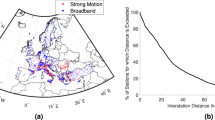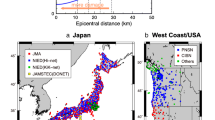Abstract
Earthquake early warning systems (EEWS) are considered to be an effective, pragmatic, and viable tool for seismic risk reduction in cities. While standard EEWS approaches focus on the real-time estimation of an earthquake’s location and magnitude, innovative developments in EEWS include the capacity for the rapid assessment of damage. Clearly, for all public authorities that are engaged in coordinating emergency activities during and soon after earthquakes, real-time information about the potential damage distribution within a city is invaluable. In this work, we present a first attempt to design an early warning and rapid response procedure for real-time risk assessment. In particular, the procedure uses typical real-time information (i.e., P-wave arrival times and early waveforms) derived from a regional seismic network for locating and evaluating the size of an earthquake, information which in turn is exploited for extracting a risk map representing the potential distribution of damage from a dataset of predicted scenarios compiled for the target city. A feasibility study of the procedure is presented for the city of Bishkek, the capital of Kyrgyzstan, which is surrounded by the Kyrgyz seismic network by mimicking the ground motion associated with two historical events that occurred close to Bishkek, namely the 1911 Kemin (M = 8.2; ±0.2) and the 1885 Belovodsk (M = 6.9; ±0.5) earthquakes. Various methodologies from previous studies were considered when planning the implementation of the early warning and rapid response procedure for real-time risk assessment: the Satriano et al. (Bull Seismol Soc Am 98(3):1482–1494, 2008) approach to real-time earthquake location; the Caprio et al. (Geophys Res Lett 38:L02301, 2011) approach for estimating moment magnitude in real time; the EXSIM method for ground motion simulation (Motazedian and Atkinson, Bull Seismol Soc Am 95:995–1010, 2005); the Sokolov (Earthquake Spectra 161: 679–694, 2002) approach for estimating intensity from Fourier amplitude spectra; and the Tyagunov et al. (Nat Hazard Earth Syst Sci 6:573–586, 2006) approach for risk computation. Innovatively, all these methods are jointly applied to assess in real time the seismic risk of a particular target site, namely the city of Bishkek. Finally, the site amplification and vulnerability datasets considered in the proposed methodology are taken from previous studies, i.e., Parolai et al. (Bull Seismol Soc Am, 2010) and Bindi et al. (Soil Dyn Earthq Eng, 2011), respectively.














Similar content being viewed by others
References
Abrakhmatov K, Havenith H-B, Delvaux D, Jongmans D, Trefois P (2003) Probabilistic PGA and Arias intensity maps of Kyrgyzstan (Central Asia). J Seismol 7:203–220
Allen RM, Kanamori H (2003) The potential for earthquake early warning in Southern California. Science 300:786–789. doi:10.1126/science.1080912
Allen RM, Gasparini P, Kamigaichi O, Böse M (2009) The status of earthquake early warning around the world: an introductory overview. Seismol Res Lett 80(5):682–693. doi:10.1785/gssrl.80.5.682
Allen TI, Wald DJ, Worden CB (2012) Intensity attenuation for active crustal regions. J Seismol. doi:10.1007/s10950-012-9278-7
Bindi D, Mayfiled M, Parolai S, Tyagunov S, Begaliev UT, Abdrakhmatov K, Moldobekov B, Zschau J (2011) Towards an improved seismic risk scenario for Bishkek, Kyrgyz Republic. Soil Dyn Earthq Eng. doi:10.1016/j.soildyn.2010.08.009
Boore DM (2009) Comparing stochastic point-source and finite-source ground-motion simulations: SMSIM and EXSIM. Bull Seism Soc Am 99:3202–3216. doi:10.1785/0120090056
Borchert RD (1970) Effects of local geology on ground motion near San Francisco Bay. Bull Seismol Soc Am 60:29–61
Bragin VD, Willemann RJ, Matix AI, Dudinskih RR, Vernon F, Offield G (2007) American Geophysical Union, Spring Meeting 2007, abstract #S23A-12
Bullen ME, Burbank DW, Garver JJ, Adbrakhmatov KY (2001) Late Cenozoic tectonic evolution of the northwestern Tien Shan: new age estimates for the initiation of the mountain building. Geol Soc Am Bull 113:1544–1559
Caprio M, Lancieri M, Cua GB, Zollo A, Wiemer S (2011) An evolutionary approach to real-time moment magnitude estimation via inversion of displacement spectra. Geophys Res Lett 38:L02301. doi:10.1029/2010GL0454403
Colombi M, Crempien J, Crowley H, Erduran E, Liu H, Lopez M et al (2010) Evaluation of seismic risk software for GEM, GEM technical report 9. GEM Foundation, Pavia, p 2010
Crotwell HP, Owens TJ, Ritsema J (1999) The TauP toolkit: flexible seismic travel-time and ray-path utilities. Seismol Res Lett 70:154–160
Cua G, Heaton T (2007) The virtual seismologist (VS) method: a Bayesian approach to earthquake early warning. In: Gasparini P, Manfredi G, Zschau J (eds) Earthquake early warning systems. Springer, Berlin. doi:10.1007/978-3-540-72241-0_7
Dolce M, Marino M, Vona M (2003) Earthquake damage scenarios of the building stock of potenza (Southern Italy) including site effects. Bull Earthq Eng 1(1):115–140. doi:10.1023/A:1024809511362
Erdik M, Fahjan Y, Ozel O, Alcik H, Mert A, Gul M (2003) Istanbul earthquake rapid response and the early warning system. Bull Earthq Eng 1(1):157–163. doi:10.1023/A:1024813612271
Erdik M, Rashidov T, Safak E, Turdukulov A (2005) Assessment of seismic risk in Tashkent, Uzbekistan, and Bishek, Kyrgyz Republic. Soil Dyn Earthq Eng 25:473–486
Festa G, Zollo A, Lancieri M (2008) Earthquakemagnitude estimation fromearly radiated energy. Geophys Res Lett 35(22):L22307. doi:10.1029/2008GL0355
Font Y, Kao H, Lallemand S, Liu C-S, Chiao L-Y (2004) Hypocentral determination offshore eastern Taiwan using maximum intersection method. Geophys J Int 158:655–675
Gasparini P, Manfredi G, Zschau J (2011) Earthquake early warning as a tool for improving society’s resilience and crisis response. Soil Dyn Earthq Eng. doi:10.1016/j.soildyn.2010.09.004
Geiger D, Verma T, Pearl J (1990) Identifying independence in Bayesian networks. Networks 20:507–534
Gruenthal G (1998) European macroseismic scale 1998 (EMS-98). Cahiers du Centre Europeen de Geodynamique et de Seismologie 1998, 15, 99. Luxembourg
Hanks TC, Kanamori H (1979) A moment magnitude scale. J Geophys Res 84(B5):2348–2350
Herrero, Bernard (1994) Modeling directivity of heterogeneous earthquake ruptures. Bull Seismol Soc Am 86(4):1149–1160
Horiuchi S, Negishi H, Abe K, Kamimura A, Fujinawa Y (2005) An automatic processing system for broadcasting earthquake alarms. Bull Seismol Soc Am 95:708–718
Housner GW (1952) Spectrum intensities of strong motion earthquakes. In: The proceedings of the symposium of earthquake and blast effects on structures. Earthquake Engineering Research Institute, Los Angeles
Iervolino I (2011) Performance-based earthquake early warning. Soil Dyn Earthq Eng. doi:10.1016/j.soildyn.2010.07.010
Januzakov KJ, Omuraliev M, Omuralieva A, Ilyasov BI, Grebennikova VV (2003) Strong earthquakes of the Tien Shan (within the Kyrgyzstan territory and adjacent regions of the countries of Central Asia). Ilim, Bishkek, p 216, 5-8355-1335-6
Kalmetieva ZA, Mikolaichuk AV, Moldobekov BD, Meleshko AV, Jantaev MM, Zubovich AV (2009) Atlas of earthquakes in Kyrgyzstan. United Nations International Strategy for Disaster Reduction Secretariat Office in Central Asia (UNISDR), Bishkek–CAIAG–2009. ISBN 978-9967-25-829-7
Kanamori H (2005) Real-time seismology and earthquake damage mitigation. Ann Rev Earth Planet Sci 33:195–214. doi:10.1146/annurev.earth.33.092203.122626
Kondorskaya NV, Shebalin NV (1982) In: Kondorskaya NV, Shebalin NV (eds) New catalog of strong earthquakes in the U.S.S.R. from ancient times through 1977. National Oceanic and Atmospheric Administration, Boulder, p 608
Lomax A (2005) A reanalysis of the hypocentral location and related observations for the great 1906 California earthquake. Bull Seismol Soc Am 95:861–877
Motazedian D, Atkinson GM (2005) Stochastic finite-fault modeling based on a dynamic corner frequency. Bull Seismol Soc Am 95:995–1010
Musson RMW, Gruenthal G, Stucchi M (2009) The comparison of macroseismic intensity scales. J Seismol. doi:10.1007/s10950-10009-19172-10950
Nakamura Y (1988) On the urgent earthquake detection and alarm system (UrEDAS). In: Proceedings of Ninth World Conference on Earthquake Engineering, Tokyo, Kyoto, Japan
Parolai S, Orunbayev S, Bindi D, Strollo A, Usupayev S, Picozzi M et al (2010) Site assessment in Bishkek (Kyrgyzstan) using earthquake and noise recording data. Bull Seismol Soc Am. doi:10.1785/0120100044
Pearl J (1985) Bayesian networks: a model of self-activated memory for evidential reasoning (UCLA Technical Report CSD-850017). Proceedings of the 7th Conference of the Cognitive Science Society. University of California, Irvine, pp 329–334
Pittore M, Wieland M, Bindi D, Parolai S, Zschau J (2011) Towards a rapid, integrated, multi-scale assessment of earthquake risk: a case study in Central Asia. Geophysical Research Abstracts, 13, EGU Joint Assembly
Pittore M, Wieland M, Parolai S, Zschau J (2012) Towards a rapid probabilistic seismic vulnerability assessment using satellite and ground-based remote sensing. Natural Hazards, Special Issue in “Remote Sensing contributing to mapping earthquake vulnerability and effects” (in press)
Rydelek P, Pujol J (2004) Real-time seismic warning with 2-station subarray. Bull Seism Soc Am 94:1546–1550
Satriano C, Lomax A, Zollo A (2008) Real-time evolutionary earthquake location for seismic early warning. Bull Seismol Soc Am 98(3):1482–1494. doi:10.1785/0120060159
Satriano C, Wu Y-M, Zollo A, Kanamori H (2011) Earthquake early warning: concepts, methods and physical grounds. Soil Dyn Earthq Eng. doi:10.1016/j.soildyn.2010.07.007
Sokolov VY (2002) Seismic intensity and Fourier acceleration spectra: revised relationship. Earthquake Spectra, 161
Sokolov VY, Chernov YK (1998) On the correlation of seismic intensity with Fourier amplitude spectra. Earthq Spectra 14:679–694
Tyagunov S, Gruenthal G, Wahlstrom R, Stempniewski L, Zschau J (2006) Seismic risk mapping for Germany. Nat Hazard Earth Syst Sci 6:573–586
Vernon F (1992) Kyrghizstan seismic telemetry network, IRIS newsletter, p. 7–9, XI, 1
Vernon F (1994) The Kyrgyz seismic network, IRIS newsletter, p. 7–8, XIII, 2
Wang R (1999) A simple orthonormalization method for stable and efficient computation of Green’s functions. Bull Seismol Soc Am 89(3):733–741
Weisstein EW (1999) Voronoi polygon, in MathWorld: a Wolfram Web Resource, http://mathworld.wolfram.com/VoronoiPolygon.html. Last accessed March 2008
Wieland M, Pittore M, Parolai S, Zschau J, Moldobekov B, Begaliev U (2012) Estimating building inventory for rapid seismic vulnerability assessment: towards an integrated approach based on multi-source imaging. Soil Dyn Earthq Eng 36:70–83
Worden CB, Gerstenberger MC, Rhoades DA, Wald DJ (2012) Probabilistic relationships between ground-motion parameters and modified Mercalli intensity in California. Bull Seismol Soc Am 102(1):204–221. doi:10.1785/0120110156
Wu YM, Kanamori H (2008) Development of an earthquake early warning system using real-time strong motion signals. Sensors 8(1):1–9. doi:10.3390/s801000
Wu Y-M, Zhao L (2006) Magnitude estimation using the first three seconds P-wave amplitude in earthquake early warning. Geophys Res Lett 33:L16312. doi:10.1029/2006GL026871
Yamamoto S, Rydelek P, Horiuchi S, Wu C, Nakamura H (2008) On the estimation of seismic intensity in earthquake early warning systems. Geophys Res Lett 35(7):L07302. doi:10.1029/2007GL033034
Zollo A, Lancieri M, Nielsen S (2006) Earthquake magnitude estimation from peak amplitudes of very early seismic signals on strong motion records. Geophys Res Lett 33:L23312. doi:10.1029/2006GL027795
Zollo A, Amoroso O, Lancieri M, Wu Y-M, Kanamori H (2010) A threshold-based earthquake early warning using dense accelerometer networks. Geophys J Int 183:963–974. doi:10.1111/j.1365-246X.2010.04765.x
Acknowledgments
The work undertaken in the paper was supported by Georisiken im Globalen Wandel (PROGRESS) and Earthquake Model Central Asia (EMCA) projects. Comments from two anonymous reviewers and from the editor A. Oth are grateful acknowledged. Discussions with K. Fleming, who also revised the English, improved the exposition of the paper.
Author information
Authors and Affiliations
Corresponding author
Rights and permissions
About this article
Cite this article
Picozzi, M., Bindi, D., Pittore, M. et al. Real-time risk assessment in seismic early warning and rapid response: a feasibility study in Bishkek (Kyrgyzstan). J Seismol 17, 485–505 (2013). https://doi.org/10.1007/s10950-012-9332-5
Received:
Accepted:
Published:
Issue Date:
DOI: https://doi.org/10.1007/s10950-012-9332-5




